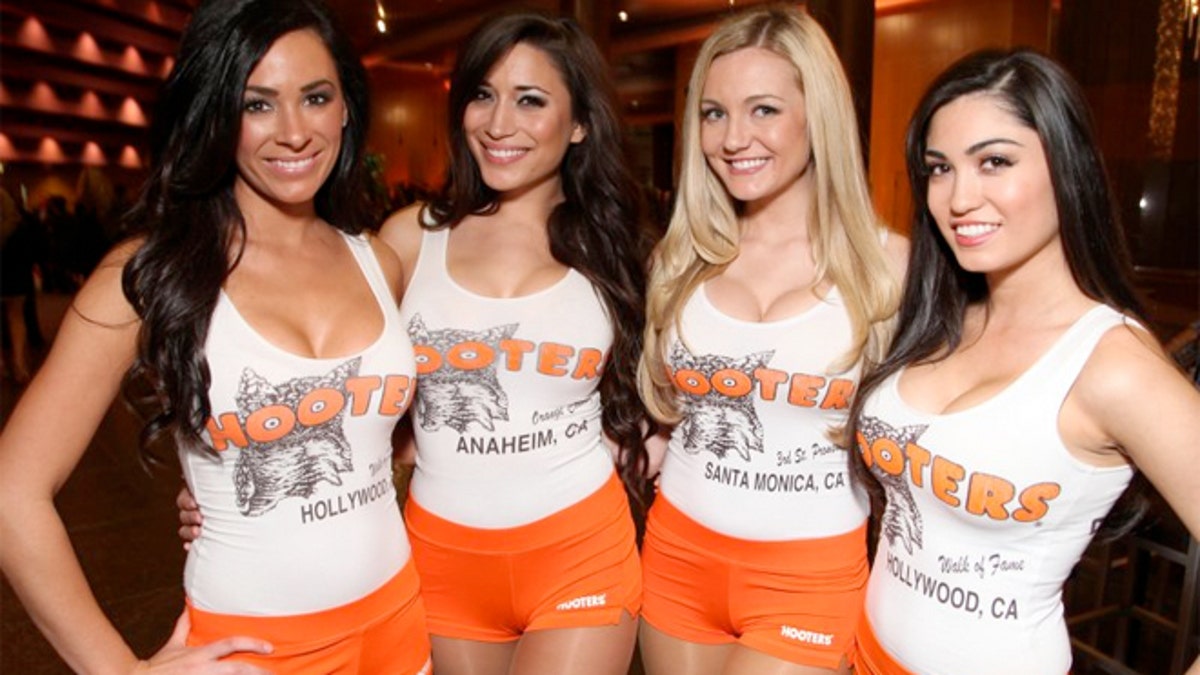
The school is asking students “to consider both what Hooters represents and whether that is something they really want to support in terms of both their faith and the value this business model places on women." (AP)
The deadly biker gang shootout last month in Waco, Texas, put the Twin Peaks restaurant chain on the map for all the wrong reasons, says the company’s CEO and founder, Randy DeWitt. Now it’s time to get back to what made his chain popular – tasty food, cold beer and scantily clad waitresses.
Those are the keys to success in the “breastaurant” business. And with that combination in mind, DeWitt is keeping his eyes on the prize: Hooters.
"The breastaurant is here to stay. If we look at our society and our culture … things are getting riskier, and people are constantly pushing boundaries."
In a recent interview with Forbes, DeWitt called out his main competition, saying the 32-year-old chain hasn’t kept up with the times. Asked if he thought Hooters, whose waitresses wear tight, low-cut t-shirts and silky orange shorts, was “racy enough,” DeWitt said, “I don’t know if I said that exactly, but certainly the brand had gotten very tired over the years.”

In 2011, Twin Peaks brought in $49.5 million at 18 locations. Last year it was $240 million at 68 locations, according to data from Technomic. (Twin Peaks)
Hooters, with 400 restaurants in 26 countries (there are plans to open 30 more in Southeast Asia alone), had a measured response to the comment – and to growing competition from other chains, including Tilted Kilt and Brick House, as well.
“We respond to the consumer, not the competition,” Mark Whittle, Hooters’ senior vice president of global development, told FoxNews.com. "Our competitive set varies greatly by country and market, and our competition differs by occasion. The weekday lunch occasion [set] is likely to be very different than our competition for a Saturday afternoon of watching college football, but are well positioned to deliver against both.”
But DeWitt's criticism of Hooters has merit, says Darren Tristano, executive vice president of Technomic, a food industry research and analytics firm. He said Hooters hasn’t been innovating while the newer chains have capitalized on its business model.
"Over the past five, maybe 10 years the original breastaurant has lost market share by standing still," Tristano said.

The standard uniform at the Tilted Kilt is a stomach-baring version of a Catholic schoolgirl uniform. (AP)
"Places like Tilted Kilt and Twin Peaks have really capitalized on new technology to make their restaurants great places to watch sporting events. You always have a great view of the TV, no matter where you sit. There's also an emphasis on cold craft beer and a strong focus on affordable, big servings of traditional comfort food."
Tristano said Hooters has a “great wing,” but it’s been slow to open new restaurants and to remodel old ones.
"They still appeal to older generations but have become a little less contemporary," he said. "Millennials didn’t grow up on Hooters. It’s where their dads went."
Whittle says Hooters has remodeled nearly 60 of its restaurants in the U.S. since 2013 and is currently working on dozens more. The chain also is aggressively going after the international market, with plans to open its largest overseas location in Pattaya, Thailand, this summer, and to have locations in hot spots like Bangkok and Samui by the end of the year.
In 2005, when DeWitt opened Twin Peaks, he saw a winning formula in beautiful women and great food, so he decided to “raise the bar on execution.” In addition to standard bar fare, Twin Peaks offers items like a Venison Chili Burger and Blackened Fish Tacos — all made from scratch. DeWitt also pointed to the chain’s frozen mugs and special beer taps, which feature a temperature gauge that keep pours at a constant 29 degrees.
And while few patrons would call the traditional Hooters uniform conservative, Twin Peaks goes a step beyond. The standard uniform at the lumberjack-themed chain is a stomach-baring flannel shirt, unbuttoned and tied right at the cleavage. Throw on a pair of khaki Daisy Dukes and the women are ready for service. At the Tilted Kilt, waitresses wear a stomach-baring version of a Catholic schoolgirl uniform.
This much is clear: The breastaurant industry is busting out all over.
In 2011, Twin Peaks brought in $49.5 million at 18 locations. Last year it was $240 million at 68 locations, according to data from Technomic. That growth has positioned it as one of the fastest growing restaurant chains in the U.S. — ahead of both Hooters and the average fast-casual and full-service chains.
And though the breastaurant business makes up a small percentage of market share (about .6 percent of a $477 billion pie), Tristano says there's a lot room to grow. There’s even a scantily clad male version, Tallywackers, popping up in Texas.
"The breastaurant is here to stay," Tristano says. "If we look at our society and our culture … things are getting riskier, and people are constantly pushing boundaries."
Though Twin Peaks may be growing faster than many of its competitors, including Hooters, it still has a long way to go before world domination. With its 69 domestic locations, it’s still a David to Hooters’ Goliath.
Tristano says Hooters’ longevity may help it maintain its status as a more family-friendly version of the breastaurant – with regular upgrades and an atmosphere that makes women feel "comfortable."
"Years ago, Hooters was considered a man's restaurant because of the uniform," Tristano says. "But now I suspect with Tilted Kilt and Twin Peaks’ skimpier clothes, you would say Hooters is PG-13. These other restaurants may be closer to R."
